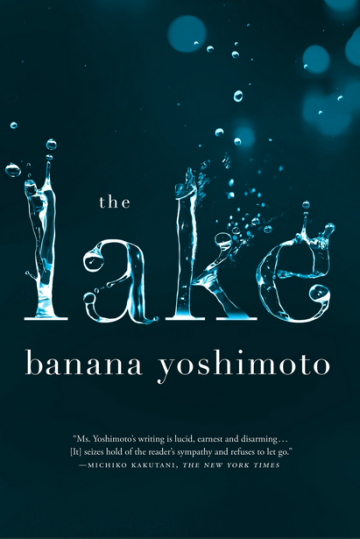THE LAKE by Banana Yoshimoto
Melville House, 2011
The Lake, is decidedly a study of two, but rather than a dialogue, the short novel functions in many ways as a dyad, a painting of two figures, a complex study of those figures in relationship to the ghosts of their respective pasts, and of course, to each other. Chihiro, the protagonist and narrator of The Lake, is a muralist living in Tokyo. Like many of Yoshimoto's characters, Chihiro is a bit offbeat; she comes from an unusual family, and she's happy, yet lonely, living an independent life. Having recently lost her mother to illness, Chihiro returns to her apartment and begins a relationship with Nakajima, a neighbor with a window across the road from her own, with whom she has shared glances, smiles, and waves for quite some time. Chihiro and Nakajima, who is mourning the less-recent loss of his own mother, gently forge a bond across the divide of their collective grief. One of the delights of the novel is Yoshimoto's finely drawn description of the tentative domestic life created by these characters. As Chihiro says, of an evening the two share a dinner of boiled tofu after work:
it felt like we were imitating some sort of lifestyle we didn't really know anything about, playing at being a happy family. Neither of us took these moments for granted, and they made us truly content.
The mystery at the heart of The Lake lies in Nakajima's past--a traumatic childhood event that has left him "extremely frail." As Nakajima begins to heal, in part due to Chihiro's strength, and in part through visits to the titular lake, the tragic events of his past come to light. Banana Yoshimoto has said of her friend, the pop-artist Yoshitomo Nara, "Like every cell in his body, each line Yoshitomo Nara draws contains all the data of his life." The same could be said of Banana Yoshimoto's spare sentences, her lines angling through the novel, creating a narrative through the accretion of her subtle assertions and luminous descriptions. Each sentence resonates with the force of an underlying worldview. For example, early in The Lake, Chihiro receives counsel, in a dream, from her recently deceased mother: “If you're always angry, always yelling at people, ultimately, that just means you depend on them.” The diction is straightforward, yet the meaning of the statement is nuanced enough to be unpacked throughout the novel's consideration of the tensions between love and independence.Likewise, Yoshimoto's writing style shares certain qualities with her protagonist's burgeoning painting style. As the novel progresses, Chihiro paints a mural on a wall between her former art school and a children's center. The mural features a brightly colored body of water surrounded by monkeys. As this meta-lake is created, little by little, Chihiro depicts characters from the novel in cheerful poses and surroundings. Here, Chihiro offhandedly cites some of her critics:
Look at her, they'd say, painting those childish pictures, she has practically no technique, and then she has the nerve to do interviews as if she were some kind of famous artist.
She is able to dismiss this criticism, stating simply that painting "was one area, just one, where I had honed my abilities to perfection," and later, "I stood up to the world, and I made my little mark." Yoshimoto, though she is a celebrated author both at home, in Japan, and abroad, marks her own work with this same humility and audacity. She sketches the difficult topics of sexuality and child abuse, for example, with the same type of strokes she uses to depict a crowded coffee shop or the bond between mother and child. In an interview about his translation of Yoshimoto's work, Michael Emmerich, the translator of The Lake, as well as several other Yoshimoto volumes, has said:
Her writing is so carefully stripped down, so beautifully balanced between the plain and the poetic, the cliched and the overwhelming, that it's very hard to write an English version that doesn't tip too far one way or the other.
Emmerich's unaffected style works to keep the balance from dipping toward the trite. The English, Emmerich notes, sounds "very American," due to his accommodation of Yoshimoto's "colloquial" Japanese. Chihiro, for example, musing on forgiveness, decides to accept her "totally uncool dad, acting like a dipstick in that cheesy Italian restaurant." This simple study of two characters, the few people who love them, and their dignified way of coping with tragedy and day-to-day life, is one of Yoshimoto's most restrained and moving works. The Lake doesn't burst with the vital imagery of Kitchen, nor does it tell the complex tale of the other early novels Amrita or N.P. Still, it alchemizes a quiet double portrait, a tentative love story, into a page-turner full of metaphysical epiphanies. Near the end of the story, after Chihiro's mural has both depicted and changed the narrative of the book, creating a haven on the painted lakeside where so many of Nakajima's difficult memories rest, Yoshimoto subtly compares Nakajima with the lake itself. Chihiro ponders Nakajima's refusal to "avert his gaze" from the darker side of the world, as well as her own inability to avert her gaze from him. In a phrase that highlights Emmerich's sense of Yoshimoto's lyric line, Chihiro concludes, "That, I think, is what it is. I'm awed by his terrible depths."
Banana Yoshimoto wrote her first novel, Kitchen, while working as a waitress at a golf-club restaurant. It sold millions of copies worldwide, and led to a phenomenon dubbed by journalists as "Bananamania." Yoshimoto has gone on to be one of the biggest-selling and most distinguished writers in Japanese history, winning numerous awards for her work. The Lake is her 13th book of fiction.

 Heather Green's two poetry chapbooks, No Omen and The Match Array, were published in 2010 by LATR Press and Dancing Girl Press, respectively. A few of her translations and original poems are forthcoming in Denver Quarterly and Barrelhouse.
Heather Green's two poetry chapbooks, No Omen and The Match Array, were published in 2010 by LATR Press and Dancing Girl Press, respectively. A few of her translations and original poems are forthcoming in Denver Quarterly and Barrelhouse.